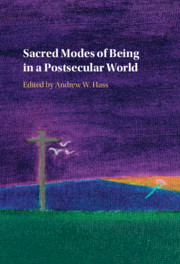Book contents
- Sacred Modes of Being in a Postsecular World
- Reviews
- Sacred Modes of Being in a Postsecular World
- Copyright page
- Contents
- Figures
- Contributors
- Acknowledgements
- Introduction
- Part I Jasper’s Sacred Mode of Being
- Chapter 1 The Sacred Opening
- Chapter 2 A Sacramental World
- Chapter 3 Sacred Thinking?
- Part II Theology’s Cultural Mode of the Sacred
- Part III Culture’s Theological Mode of the Sacred
- Bibliography
- Index
Chapter 1 - The Sacred Opening
from Part I - Jasper’s Sacred Mode of Being
Published online by Cambridge University Press: 07 September 2021
- Sacred Modes of Being in a Postsecular World
- Reviews
- Sacred Modes of Being in a Postsecular World
- Copyright page
- Contents
- Figures
- Contributors
- Acknowledgements
- Introduction
- Part I Jasper’s Sacred Mode of Being
- Chapter 1 The Sacred Opening
- Chapter 2 A Sacramental World
- Chapter 3 Sacred Thinking?
- Part II Theology’s Cultural Mode of the Sacred
- Part III Culture’s Theological Mode of the Sacred
- Bibliography
- Index
Summary
In the ongoing irresolution between religion and the secular, this chapter looks at the notion of the sacred as something always and already resolved to its counterpart, the profane. In defining the sacred as the opening of the world to its own outside, the chapter explores the reaches of this opening in relation to David Jasper’s Sacred Trilogy. Across Jasper’s texts the sacred opens us to a mystical possibility embodied in spaces both real and imagined – such as desert, body or community – where the ascetic and the aesthetic come together. The chapter shows how this embodiment inhabits or dwells within a liturgical space by looking at liturgy’s “ergon” as cultural and communal poesis, which takes both individual and community to their own outside. This “ergon” is thus also a movement, a traversing with reverent care and a respectful silence towards “the impossible possibility of absolute vision” (Jasper). That vision enfolds together literature, art, religion, philosophy and sacrament in order to make possible within our world an impossibility that opens up our world, an opening that is both discovery and loss, both voice and silence, both all and nothing.
- Type
- Chapter
- Information
- Sacred Modes of Being in a Postsecular World , pp. 15 - 30Publisher: Cambridge University PressPrint publication year: 2021

